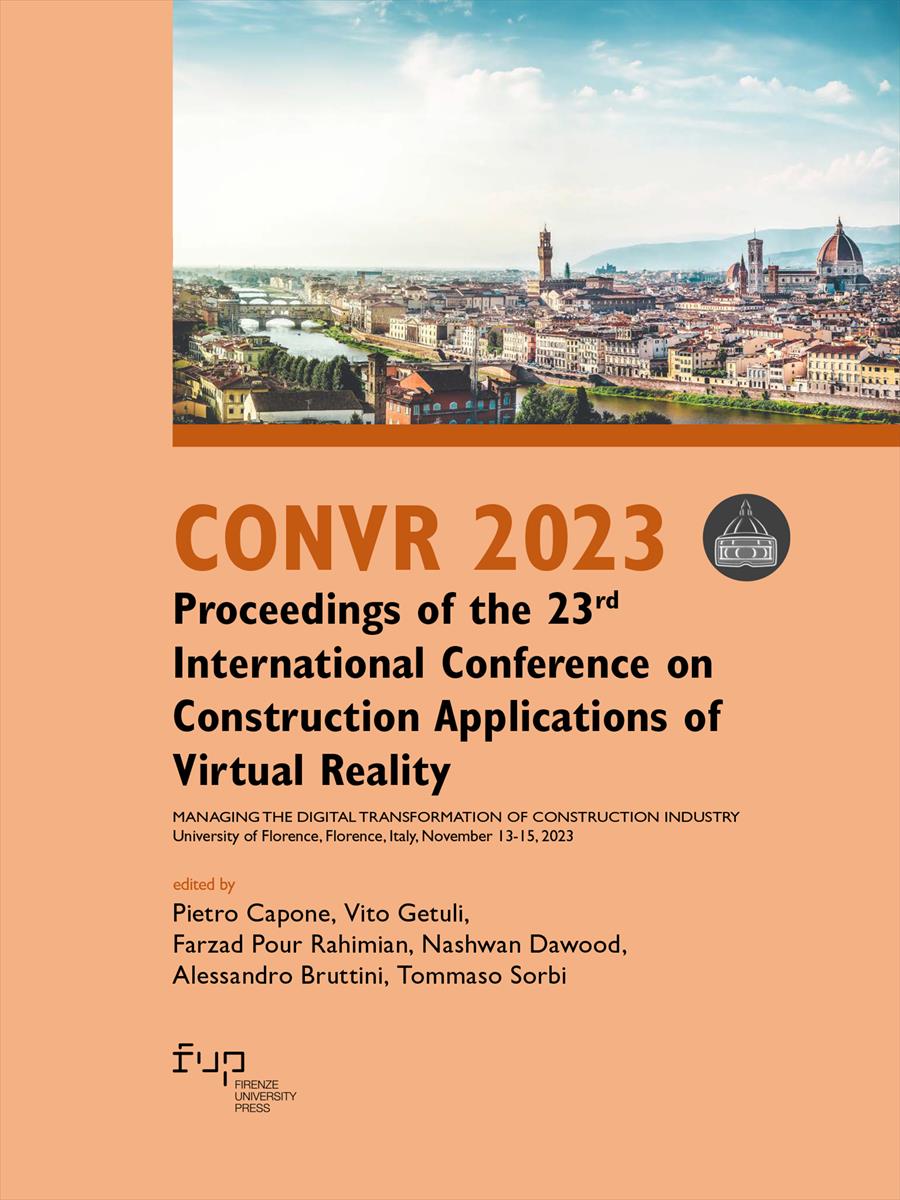- CONVR 2023 - Proceedings of the 23rd International Conference on Construction Applications of Virtual Reality
- Edited by Pietro Capone, Vito Getuli, Farzad Pour Rahimian, Nashwan Dawood, Alessandro Bruttini, Tommaso Sorbi
Testing ChatGPT-Aided SPARQL Generation for Semantic Construction Information Retrieval
- Yuan Zheng
- Olli Seppänen
- Sebastian Seiß
- Jürgen Melzner
- © 2023 Author(s) |
- CC BY-NC 4.0
- DOI: 10.36253/979-12-215-0289-3.75
Recently there has been a strong interest in using semantic technologies to improve information management in the construction domain. Ontologies provide a formalized domain knowledge representation that provides a structured information model to facilitate information management issues such as formalization and integration of construction workflow information and data and enables further applications such as information retrieval and reasoning. SPARQL Protocol And RDF Query Language (SPARQL) queries are the main approaches to conduct the information retrieval from the Resource Description Framework (RDF) format data. However, there is a barrier for end users to develop the SPARQL queries, as it requires proficient skills to code them. This challenge hinders the practical application of ontology-based approaches on construction sites. As a generative language model, ChatGPT has already illustrated its capability to process and generate human-like text, including the capability to generate the SPARQL for domain-specific tasks. However, there are no specific tests evaluating and assessing the SPARQL-generating capability of ChatGPT within the construction domain. Therefore, this paper focuses on exploring the usage of ChatGPT with a case of importing the Digital Construction Ontologies (DiCon) and generating SPARQL queries for specific construction workflow information retrieval. We evaluate the generated queries with metrics including syntactical correctness, plausible query structure, and coverage of correct answers
- Keywords:
- Semantic web,
- Ontology,
- ChatGPT,
- SPARQL,
- RDF,
- Information retrieval,
- Construction,
Aalto University, Finland - ORCID: 0000-0002-9845-1138
Aalto University, Finland - ORCID: 0000-0002-2008-5924
Bauhaus-University Weimar, Germany - ORCID: 0000-0001-5808-695X
Bauhaus-University Weimar, Germany - ORCID: 0000-0002-6435-0283
- Akinci, B. (2015). Situational awareness in construction and facility management. Frontiers of Engineering Management, 1(3), 283-289. DOI: 10.15302/j-fem-2014037
- Akinyemi, A., Sun, M., & Gray, A. J. (2018). An ontology-based data integration framework for construction information management. Proceedings of The Institution of Civil Engineers-Management, Procurement and Law, 171(3), 111-125. DOI: 10.1680/jmapl.17.00052
- Allemang, D., Hendler, J., & Gandon, F. (2020). Semantic Web for the Working Ontologist. New York, NY, USA: ACM. DOI: 10.1016/C2010-0-68657-3
- Beetz, J., Pauwels, P., McGlinn, K., Tormä, S. (2021). Linked Data im Bauwesen. In: Borrmann, A., König, M., Koch, C., Beetz, J. (eds) Building Information Modeling. VDI-Buch. Wiesbaden: Springer Vieweg. DOI: 10.1007/978-3-658-33361-4_11
- El-Diraby, T. E., & Osman, H. (2011). A domain ontology for construction concepts in urban infrastructure products. Automation in Construction, 20(8), 1120–1132. DOI: 10.1016/j.autcon.2011.04.014
- El-Gohary, N. M., & El-Diraby, T. E. (2010). Domain ontology for processes in infrastructure and construction. Journal of Construction Engineering and Management, 136(7), 730–744. DOI: 10.1061/(asce)co.1943-7862.0000178
- Hitzler, P., Krötzsch, M., Rudolph, S., & Sure-Vetter, Y. (2007). Semantic Web. Grundlagen. Berlin, Heidelberg: Springer Berlin Heidelberg (SpringerLink Bücher). DOI: 10.1007/978-3-540-33994-6
- Janowicz, K., Haller, A., Cox, S. J., Le Phuoc, D., & Lefrançois, M. (2019). SOSA: A lightweight ontology for sensors, observations, samples, and actuators. Journal of Web Semantics, 56, 1-10. DOI: 10.1016/j.websem.2018.06.003
- Kosovac, B., Froese, T., & Vanier, D. (2000). Integrating heterogeneous data representations in model-based AEC/FM systems. Proceedings of CIT, 2, 556-567. Retrieved July 23, 2023, from https://itc.scix.net/paper/w78-2000-556
- Lin, W., Babyn, P., & Zhang, W. (2023). Context-based Ontology Modelling for Database: Enabling ChatGPT for Semantic Database Management. Retrieved July 23, 2023, from arXiv preprint arXiv:2303.07351.
- Manola, F., Miller, E., & McBride, B. (2004). RDF primer. W3C recommendation, 10(1-107), 6.
- Meyer, L. P., Stadler, C., Frey, J., Radtke, N., Junghanns, K., Meissner, R., ... & Martin, M. (2023). LLM-assisted Knowledge Graph Engineering: Experiments with ChatGPT. Retrieved July 23, 2023, from arXiv preprint arXiv:2307.06917.
- Ontotext. (2023). GraphDB. Retrieved July 23, 2023, from https://graphdb.ontotext.com/.
- OpenAI. (2023). GPT-4 is OpenAI’s most advanced system, producing safer and more useful responses. Retrieved July 23, 2023, from https://openai.com/gpt-4.
- Pauwels, P., & Terkaj, W. (2016). EXPRESS to OWL for the construction industry: Towards a recommendable and usable ifcOWL ontology. Automation in Construction, 63,100-133. DOI: 10.1016/j.autcon.2015.12.003
- Rasmussen, M. H., & Lefrançois, M. (2018). Ontology for property management. Retrieved July 23, 2023, from https://w3c-lbd-cg.github.io/opm/.
- Tan, Y., Min, D., Li, Y., Li, W., Hu, N., Chen, Y., & Qi, G. (2023). Evaluation of ChatGPT as a question answering system for answering complex questions. Retrieved July 23, 2023, from arXiv preprint arXiv:2303.07992.arXiv:2307.11449.
- Technology Innovation Institute. (2023). Introducing Falcon LLM. Retrieved July 23, 2023, from https://falconllm.tii.ae/.
- Van Dis, E. A., Bollen, J., Zuidema, W., van Rooij, R., & Bockting, C. L. (2023). ChatGPT: five priorities for research. Nature, 614(7947), 224-226. DOI: 10.1038/d41586-023-00288-7
- White, J., Fu, Q., Hays, S., Sandborn, M., Olea, C., Gilbert, H., Elnashar, A., Spencer-Smith, J., & Schmidt, D. C. (2023). A prompt pattern catalog to enhance prompt engineering with chatgpt. Retrieved July 23, 2023, from arXiv preprint arXiv:2302.11382.
- Harris, S., & Seaborne, A. (2013). SPARQL 1.1 Query Language: W3C Recommendation 21 March 2013. W3C Recommendations. Retrieved July 23, 2023, from https://www.w3.org/TR/sparql11-query/.
- Zheng, Y., Törmä, S., & Seppänen, O. (2021). A shared ontology suite for digital construction workflow. Automation in Construction, 132, 1–24. DOI: 10.1016/j.autcon.2021.103930
Chapter Information
Chapter Title
Testing ChatGPT-Aided SPARQL Generation for Semantic Construction Information Retrieval
Authors
Yuan Zheng, Olli Seppänen, Sebastian Seiß, Jürgen Melzner
DOI
10.36253/979-12-215-0289-3.75
Peer Reviewed
Publication Year
2023
Copyright Information
© 2023 Author(s)
Content License
Metadata License
Bibliographic Information
Book Title
CONVR 2023 - Proceedings of the 23rd International Conference on Construction Applications of Virtual Reality
Book Subtitle
Managing the Digital Transformation of Construction Industry
Editors
Pietro Capone, Vito Getuli, Farzad Pour Rahimian, Nashwan Dawood, Alessandro Bruttini, Tommaso Sorbi
Peer Reviewed
Publication Year
2023
Copyright Information
© 2023 Author(s)
Content License
Metadata License
Publisher Name
Firenze University Press
DOI
10.36253/979-12-215-0289-3
eISBN (pdf)
979-12-215-0289-3
eISBN (xml)
979-12-215-0257-2
Series Title
Proceedings e report
Series ISSN
2704-601X
Series E-ISSN
2704-5846
